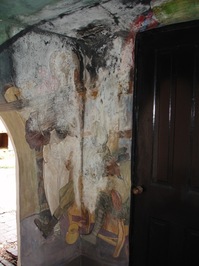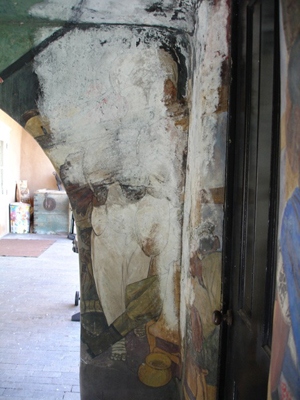 Deterioration of fresco paintings results from the open, porous nature of their support (walls and ceilings of buildings or other carriers) and their interaction with the surrounding micro climates.
Deterioration of fresco paintings results from the open, porous nature of their support (walls and ceilings of buildings or other carriers) and their interaction with the surrounding micro climates.
The porous mortar backing provides an easy route for the movement of dilute salt solutions. Salts contained in the building materials or the surrounding area can be readily transported to the plaster underlying the painting. Old leaky roof, clogged gutters or subterranean walls and/or semi-buried walls – anything that would cause water to soak and remain in the wall will eventually bring salts from adjasent areas into the plaster. The wall and fresco can get wet from the rains and not be affected as long as it is exposed to freely moving air that would dry it naturally.
Expansion in volume associated with crystallization of these salts disrupts the plaster-pigment adhesion and leads to disintegration of the surface. Such crystallization depends on the identity of the salts and the moisture content of masonry which is subject to seasonal variations in atmospheric humidity and the amount of rain.
 Conservation methods have been developed to remove salts formed from reactions of sulfate ion traveling through the mortar. When the sulfate ion reacts with calcium, it forms calcium sulfate, gypsum. Since gypsum is more soluble than calcium carbonate, it dissolves and re-crystallizes with changes in humidity. These cycles lead to severe damage when the gypsum crystallizes just beneath or throughout the paint layer.
Conservation methods have been developed to remove salts formed from reactions of sulfate ion traveling through the mortar. When the sulfate ion reacts with calcium, it forms calcium sulfate, gypsum. Since gypsum is more soluble than calcium carbonate, it dissolves and re-crystallizes with changes in humidity. These cycles lead to severe damage when the gypsum crystallizes just beneath or throughout the paint layer.
Florentine floods of 1966 spurred the development of a conservation treatment, the “Barium Method,” in which a series of poultices are applied to such sulfate-damaged fresco paintings to form the less soluble barium sulfate from calcium sulfate The first step in this procedure solubilizes calcium sulfate.
A thick swab of soft absorbent paper (paper towel) containing a supersaturated solution of ammonium carbonate [(NH4)2CO3] is applied to the surface of the fresco so that the solution is absorbed by the wall.
Any calcium carbonate forming on the surface of painting is swabbed away; whereas, that formed within the plaster helps re-establish cohesion.
CaSO4) + (NH4)2CO3(aq) [(NH4)2SO4(aq) + CaCO3(s)
It is followed by application of a solution containing Barium Hydroxide also applied using thick swab of soft absorbent paper (paper towel). Barium Hydroxide converts any remaining calcium sulfate present into the less soluble barium sulfate:
Ba(OH)2(aq + CaSO4(s) BaSO4(s) + Ca(OH-)2
The excess barium hydroxide is homogeneously absorbed into the intonaco. It reacts with any sulfate ion present to form barium sulfate and arrests further migration of this ion or with atmospheric carbon dioxide to act as a binding agent to consolidate the plaster and pigments:
Ba(OH)2(aq + CO2 BaCO3(s) + H2O
 The scientific basis of this conservation rests on differences in the solubility of several salts. The barium method was applied to restoration of the frescoes of Brancacci Chapel in Florence in which calcium sulfate had been shown to be the major agent of destruction. The second most common cause of deterioration of frescoes comes from previous conservation efforts in which early conservationists attempted to protect the fresco or brighten colors with glues, oils, egg white and/or waxes.
The scientific basis of this conservation rests on differences in the solubility of several salts. The barium method was applied to restoration of the frescoes of Brancacci Chapel in Florence in which calcium sulfate had been shown to be the major agent of destruction. The second most common cause of deterioration of frescoes comes from previous conservation efforts in which early conservationists attempted to protect the fresco or brighten colors with glues, oils, egg white and/or waxes.
In time, these organic materials darken, shrink, and lift off paint layers. In addition, they provide nutrients for the growth of microorganisms and prevent the exchange of moisture and air between the fresco and atmosphere. Recent restoration of the Sistine Chapel frescoes focused on removing the residues of early conservation efforts by treating the frescoes with a cleaning solution to solubilize glues and waxes. The cleaning solution contained ammonium bicarbonate, (NH4)2CO3(aq) to remove calcium sulfate (equation 1).
Consolidation of loose paint and intonaco was, however, done with polymeric injections as the paintings in the Sistine Chapel contained low levels of sulfates, but high levels of nitrates, a counter indication to barium hydroxide treatment. We can only speculate on the reasons why the barium method would be inappropriate under these conditions.
Barium method can be used to treat restore/conserve lime plaster walls ceilings, etc.



